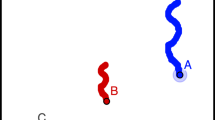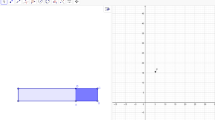Abstract
Dynamic geometry software provides tools for students to construct and experiment with geometrical objects and relationships. On the basis of their experimentation, students make conjectures that can be tested with the tools available. In this paper, we explore the role of software tools in geometry problem solving and how these tools, in interaction with activities that embed the goals of teachers and students, mediate the problem solving process. Through analysis of successful student responses, we show how dynamic software tools can not only scaffold the solution process but also help students move from argumentation to logical deduction. However, by reference to the work of less successful students, we illustrate how software tools that cannot be programmed to fit the goals of the students may prevent them from expressing their (correct) mathematical ideas and thus impede their problem solution.
Similar content being viewed by others
Explore related subjects
Discover the latest articles, news and stories from top researchers in related subjects.REFERENCES
Arzarello, F., Micheletti, C., Olivero, F., Robutti O., Paola, D. and Gallino, G. (1998). Dragging in Cabri and modalities of transition from conjectures to proofs in geometry. In A. Olivier and K. Newstead (Eds), Proceedings of PME 22, Vol. 2 (pp. 32-39). South Africa: University of Stellenbosch.
Bartolini Bussi, M. and Mariotti, M. A. (1999). Semiotic mediation: From history to the mathematics classroom. For the Learning of Mathematics 19(2): 27-35.
Chazan, D. and Yerushalmy, M. (1998). Charting a course for secondary geometry. In R. Lehrer and D. Chazan (Eds), Designing Learning Environments for Developing Understanding of Geometry and Space. New Jersey/London: LEA.
Cole, M. and Wertsch, J. V. (1996). Beyond the individual-social antinomy in discussions of Piaget and Vygotsky. Human Development 39: 250-256.
diSessa, A. (2000). Changing Minds, Computers, Learning, and Literacy. USA/England: MIT Press.
diSessa, A., Hoyles, C. and Noss, R. with Edwards, L. (Eds) (1995). Computers for Exploratory Learning. Springer-Verlag.
Eisenberg, M. (1995). Creating software applications for children: Some thoughts about design. In A. diSessa, C. Hoyles and R. Noss with L. Edwards (Eds), Computers for Exploratory Learning (pp. 175-198). Springer-Verlag.
Garuti, R., Boero, P. and Lemut, E. (1998). Cognitive unity of theorems and difficulties of proof. In the Proceedings of the Twenty-second International Conference for the Psychology of Mathematics Education, Vol. 2 (pp. 345-352).
Goldenberg, P. (2001). Getting Euler's line to relax. International Journal of Computers for Mathematical Learning 6(2): 215-228.
Goldenberg, P. and Cuoco, A. (1998). What is dynamic geometry? In R. Lehrer and D. Chazan (Eds), Designing Learning Environments for Developing Understanding of Geometry and Space. Hilldale, NJ: LEA.
Grenier D. (2000). Learning proof and modelling. Inventory of teaching practice and new problems. Contribution to: Paolo Boero, G. Harel, C. Maher, M. Miyazaki (organisers), Proof and Proving in Mathematics Education. ICME9 TSG 12. Tokyo/Makuhari, Japan.
Healy, L. and Hoyles, C. (1998). Technical report on the nationwide survey. Justifying and Proving in School Mathematics. London: Institute of Education, University of London.
Healy, L. and Hoyles, C. (2000). A study of proof conceptions in algebra. Journal for Research in Mathematics Education 31(4): 396-428.
Healy, L., Höelzl, R., Hoyles, C. and Noss, R., (1994). Messing up. Micromath 10(1): 14-16.
Hölzl, R. (1996). How does 'dragging' affect the learning of geometry. International Journal of Computers for Mathematical Learning 1(2): 169-187.
Hoyles, C. (1996). Modelling geometrical knowledge: The case of the student. I J-M. Laborde (Ed), Intelligent Learning Environments: The Case of Geometry. Springer, NATO I Series.
Hoyles, C. and Noss, R. (1992). Learning Mathematics and Logo. USA/London: MIT Press.
Hoyles, C. and Sutherland R. (1989). Logo Mathematics in the Classroom. London and New York: Routledge.
Hoyles, C. and Healy, L. (1999). Linking informal argumentation with formal proof through computer-integrated teaching experiments. In the Proceedings of the Twentythird International Conference for the Psychology of Mathematics Education. Haifa, Israel.
Hoyles, C. and Healy, L. (in press). Curriculum change and geometrical reasoning. Submitted to Boero, P. (Ed.), Theorems in School. Kluwer.
Hoyles, C. (1998). A Culture of proving in school mathematics? In D. Tinsley and D.C. Johnson (Eds), Information and Communications Technologies in School Mathematics (pp. 169-181). Chapman & Hall.
Jones, K. (1998). The mediation of learning within a dynamic geometry environment. In the Proceedings of the Twenty-second International Conference for the Psychology of Mathematics Education, Vol. 3 (pp. 96-103). Stellenbosch, South Africa.
Laborde, C. and Laborde, J-M. (1995).What about a learning environment where euclidean concepts are manipulated with a mouse? In A. diSessa, C. Hoyles and R. Noss with L. Edwards (Eds), Computers for Exploratory Learning (pp. 241-261). Springer-Verlag.
Laborde, J-M. (1999). Quinze Ans de Cabri-Géomètre, un Bilan. Paper presented at CabriWorld, 1st International Congress about Cabri-Géomètre. São Paulo.
Love, E. (1996). Letting go: An approach to geometric problem solving. In Proceedings of the Twenty-second International Conference for the Psychology of Mathematics Education, Vol. 3 (pp. 281-288). Spain: Valencia.
Noss, R. and Hoyles, C. (1996). Windows on Mathematical Meanings: Learning Cultures and Computers. Dordrecht: Kluwer.
Vygotsky, L. S. (1981). The instrumental method in psychology. In J. V. Wertsch (Ed.), The Concept of Activity in Soviet Psychology (pp. 134-143). Armonk, NY: M.E. Sharpe.
Wertsh, J. V. (1998). Mind as Action. New York: Oxford University Press.
Author information
Authors and Affiliations
Rights and permissions
About this article
Cite this article
Healy, L., Hoyles, C. Software Tools for Geometrical Problem Solving: Potentials and Pitfalls. International Journal of Computers for Mathematical Learning 6, 235–256 (2002). https://doi.org/10.1023/A:1013305627916
Issue Date:
DOI: https://doi.org/10.1023/A:1013305627916




